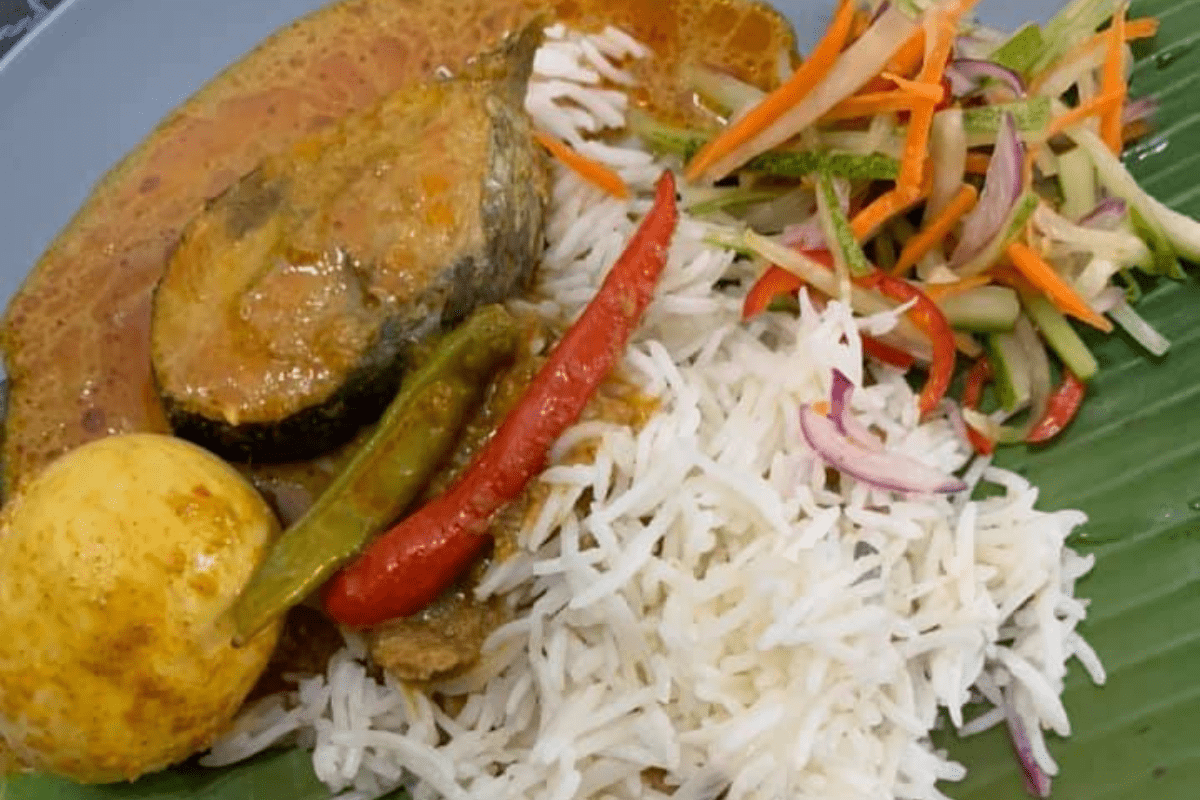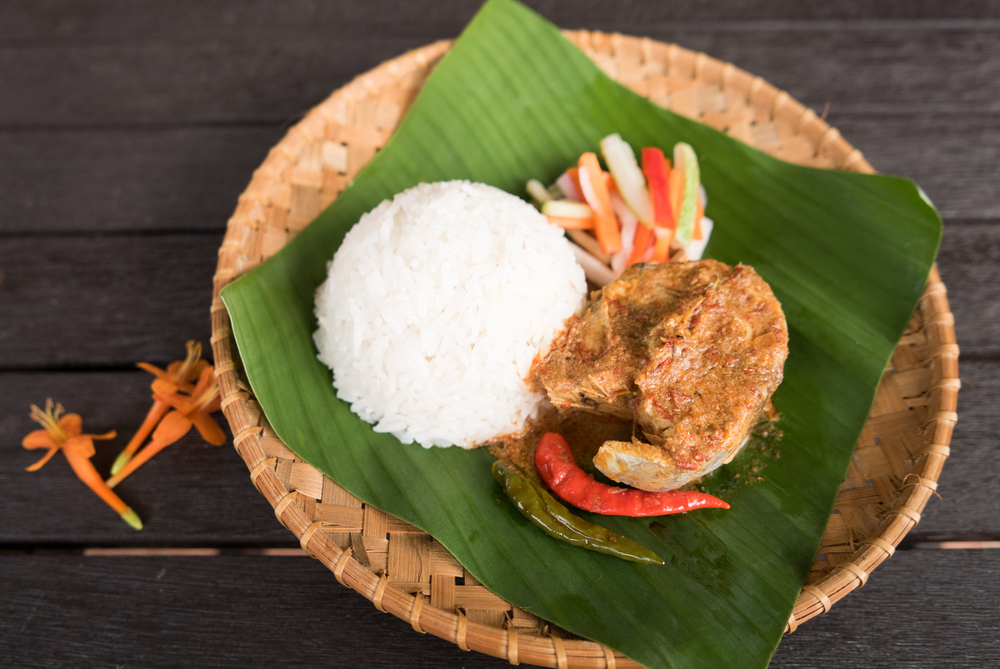Embark on a culinary adventure to the heart of Malaysia’s Terengganu region with our exploration of the iconic Nasi Dagang Terengganu. This beloved dish, a symphony of flavors and textures, is a testament to the rich cultural heritage of the East Coast.
Join us as we delve into its ingredients, cooking methods, regional variations, and cultural significance, culminating in a step-by-step recipe that will transport you to the bustling kitchens of Terengganu.
Nasi Dagang Terengganu, a staple in Malaysian cuisine, is a fragrant rice dish that captivates the senses with its medley of spices, aromatic herbs, and tender meats. Traditionally cooked in a bamboo steamer over a charcoal fire, this dish embodies the essence of Terengganu’s culinary traditions.
Ingredients

Nasi Dagang Terengganu, a fragrant and flavorful dish, owes its distinctive taste to a harmonious blend of ingredients. These ingredients, meticulously selected and combined, create a culinary masterpiece that captivates the senses.
The foundation of Nasi Dagang Terengganu lies in its fragrant rice, which is cooked in a rich coconut milk broth infused with spices and aromatics. The meats, typically beef or chicken, are tender and succulent, adding depth and substance to the dish.
The symphony of flavors is further enhanced by a medley of vegetables and condiments, each contributing its unique character to the overall taste experience.
Rice
- Fragrant rice: Jasmine rice or basmati rice, known for their delicate aroma and fluffy texture, are commonly used.
- Coconut milk: Rich and creamy, coconut milk imparts a subtle sweetness and velvety texture to the rice.
Spices
- Cumin seeds: Earthy and aromatic, cumin seeds add warmth and depth to the dish.
- Coriander seeds: With their citrusy and slightly sweet notes, coriander seeds bring a refreshing balance to the spices.
- Fennel seeds: Anise-like in flavor, fennel seeds provide a subtle sweetness and a hint of licorice.
- Cloves: Aromatic and slightly pungent, cloves add a touch of warmth and complexity to the spice blend.
Aromatics
- Shallots: Mild and slightly sweet, shallots provide a subtle oniony flavor and enhance the overall aroma.
- Garlic: Essential for its pungent and savory notes, garlic adds depth and complexity to the dish.
- Ginger: Fresh ginger, with its spicy and slightly sweet flavor, brings a refreshing balance to the aromatics.
- Lemongrass: Aromatic and citrusy, lemongrass imparts a unique and refreshing flavor to the dish.
Meats
- Beef: Tender and flavorful, beef is a popular choice for Nasi Dagang Terengganu.
- Chicken: Chicken, with its milder flavor, provides a leaner alternative to beef.
Vegetables
- Cucumbers: Sliced cucumbers add a refreshing crunch and coolness to the dish.
- Red onions: Finely sliced red onions provide a sharp and slightly sweet contrast to the other ingredients.
- Chilies: Green or red chilies, depending on the desired level of spiciness, add a fiery kick to the dish.
Condiments
- Budu: A fermented fish sauce, budu adds a unique salty and slightly sour flavor to the dish.
- Sambal: A spicy chili paste, sambal provides an additional layer of heat and flavor.
Cooking Methods
Nasi Dagang Terengganu is traditionally cooked using two methods: steaming and grilling.
Steaming involves cooking the rice in a bamboo steamer placed over a pot of boiling water. The rice is steamed until it is fluffy and cooked through.
Grilling
Grilling involves cooking the rice on a grill over hot coals. The rice is grilled until it is slightly browned and cooked through.
Regional Variations
Nasi Dagang Terengganu, a culinary masterpiece from the east coast of Malaysia, exhibits regional variations that reflect the diverse cultural influences and culinary traditions of the states it’s found in. Each variation boasts unique ingredients, flavors, and cooking techniques, adding to the rich tapestry of this beloved dish.
Nasi Dagang Kelantan
In neighboring Kelantan, Nasi Dagang Kelantan distinguishes itself with the addition of “gulai kawah,” a flavorful curry cooked in a large cauldron over an open fire. This rich and spicy curry is a key component of the dish, adding a depth of flavor that tantalizes the taste buds.
Nasi Dagang Kuala Terengganu
The coastal capital of Terengganu, Kuala Terengganu, offers its own interpretation of Nasi Dagang Terengganu. Here, the nasi is cooked with turmeric, lending it a vibrant yellow hue. The accompanying gulai is typically less spicy, allowing the natural flavors of the fish to shine through.
Cultural Significance
Nasi Dagang Terengganu is a dish that holds deep cultural significance in Malaysian cuisine, particularly in the Terengganu region where it originated.
The dish is intricately woven into the fabric of Terengganu’s history and heritage, serving as a culinary symbol of the state’s unique traditions and identity.
Role in Traditional Festivals and Ceremonies
Nasi Dagang Terengganu plays a prominent role in various traditional festivals and ceremonies celebrated in the Terengganu region.
During the festive season of Hari Raya Aidilfitri, Nasi Dagang Terengganu is a must-have dish that graces dining tables across the state. It is also a staple dish served at weddings, engagement ceremonies, and other important social gatherings.
Reflection of History and Heritage
The ingredients and preparation methods of Nasi Dagang Terengganu offer a glimpse into the rich history and heritage of the Terengganu region.
The use of glutinous rice, a staple crop in Terengganu, speaks to the region’s agricultural traditions. The incorporation of spices like turmeric and lemongrass reflects the influence of Malay and Indian culinary practices.
Presentation and Accompaniments

Nasi Dagang Terengganu is traditionally presented on a large banana leaf, creating a rustic and authentic ambiance. The rice is generously heaped in the center, forming a pyramid-like shape. Surrounding the rice, various accompaniments are artfully arranged, each contributing its distinct flavors and textures to the overall dish.
Typical Accompaniments
The classic accompaniments to Nasi Dagang Terengganu include:
- Acar: A tangy and refreshing pickled vegetable salad, typically made with cucumbers, carrots, onions, and chilies.
- Sambal: A spicy chili paste that adds a fiery kick to the dish. The most common sambal used with Nasi Dagang Terengganu is sambal kicap, made with chili, soy sauce, and sugar.
- Gulai: A thick and flavorful curry, usually made with fish or beef. Gulai tempoyak, made with fermented durian, is a popular choice for Nasi Dagang Terengganu.
Garnishing and Styling
For special occasions, Nasi Dagang Terengganu can be garnished and styled to enhance its visual appeal. Here are some tips:
- Use fresh herbs, such as cilantro or parsley, to add a touch of greenery.
- Place a fried egg on top of the rice for a colorful and indulgent touch.
- Create a decorative border around the banana leaf with thinly sliced cucumbers or carrots.
Recipe Development
Nasi Dagang Terengganu is a complex dish with multiple components, but it can be made at home with careful preparation and attention to detail.
The following recipe will guide you through the steps of making this dish, from preparing the ingredients to cooking the rice and assembling the dish. Variations and modifications are also provided to suit different preferences.
Ingredients
- For the rice:
- 2 cups long-grain rice
- 4 cups water
- 1 teaspoon salt
- For the gulai:
- 1 pound beef or chicken, cut into small pieces
- 1 onion, chopped
- 2 cloves garlic, minced
- 1 teaspoon ginger, minced
- 1 teaspoon turmeric powder
- 1 teaspoon cumin powder
- 1 teaspoon coriander powder
- 1 teaspoon chili powder
- 1 cup coconut milk
- 1/2 cup water
- Salt to taste
- For the accompaniments:
- Sambal belacan
- Fried shallots
- Hard-boiled eggs
- Cucumber slices
Conclusion
Our journey into the world of Nasi Dagang Terengganu has unveiled the intricacies and allure of this culinary masterpiece. From its humble origins to its elevated status as a symbol of cultural pride, this dish continues to enchant food lovers near and far.
Whether you are a seasoned cook or a novice in the kitchen, we encourage you to embark on your own culinary adventure and recreate this flavorful dish in your home. Embrace the traditions and flavors of Terengganu, and savor every bite of this unforgettable Malaysian delicacy.
FAQs
What is the secret to achieving the perfect balance of flavors in Nasi Dagang Terengganu?
The key lies in the careful selection and blending of spices. Each ingredient, from the fragrant cumin to the fiery chili peppers, plays a vital role in creating the harmonious flavor profile that defines this dish.
How can I adapt the recipe to suit my dietary preferences?
Nasi Dagang Terengganu is a versatile dish that can be easily adapted to accommodate various dietary needs. For a vegetarian version, simply omit the meat and substitute vegetable broth for the meat stock. Gluten-free options are also possible by using gluten-free rice and tamari sauce instead of soy sauce.
What are some popular accompaniments to Nasi Dagang Terengganu?
Traditionally, Nasi Dagang Terengganu is served with a variety of accompaniments, including acar (pickled vegetables), sambal (chili paste), and gulai (curry). These side dishes enhance the flavors of the rice and provide a delightful contrast in textures.
